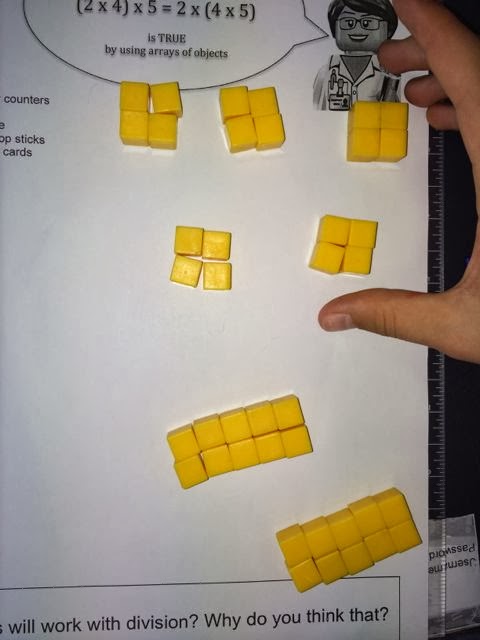So, we brought the multiplication process into the Associative spotlight.
Now we were getting into some interesting territory.
Having spent the last two weeks:
1. learning about the Commutative and Associative Laws
and..
2. experimenting with using arrays
...we were now in a place where we could start thinking for ourselves and the teacher could take a bit more of a backseat.
So once again we pulled out the counters and started thinking about the provocation.
A nice looking display - at the top we have 5 groups of 4 x 2
and underneath we can see 2 groups of 4 x 5
So when we put them together we can see that the two groups
are the same. Nice proof.
This one was a bit confusing to me. We've got 4 x 5 at the top
and 2 lots of 2 x 5 at the bottom. Not quite the same as the provocation at the top.
So we reorganised things a bit and had a chat about what we were looking for.
I find these little chats that follow moments of confusion really significant -
helps me to assess and diagnose.
And just when I thought everything was going so smoothly, I came across this
example of someone trying to model the symbolic notation using blocks
rather than making an array.
Time to reflect on my tuning in process for this inquiry.
Having come this far, we are going to finish with the Distributive Law later in the week.
Can't do it tomorrow because we have "Gruffalo Day"
...but that is another story!







Did anyone make a 3-dimensional representation? e.g. a stack of two 4 by 5 arrays and then, say, a stack of five 2 by 4 arrays? Just wondering, 'cause that's how I saw it at first!
ReplyDeleteHi Mr. Ferrington! I can see you are still having fun with the laws of math. I continue to enjoy reading your posts about the different ways of teaching math. I like how you use the tiles and blocks to informally assess whether the students understand the concept. I look forward to learning more about teaching math from your blog. Have fun at Gruffalo Day!
ReplyDeleteHi Sarah. Good to hear from you. Glad you are enjoying the blog. I think it is important to use a range of different assessments to help get a broad picture of the understanding of each child. Not all methods suit all children.
Delete